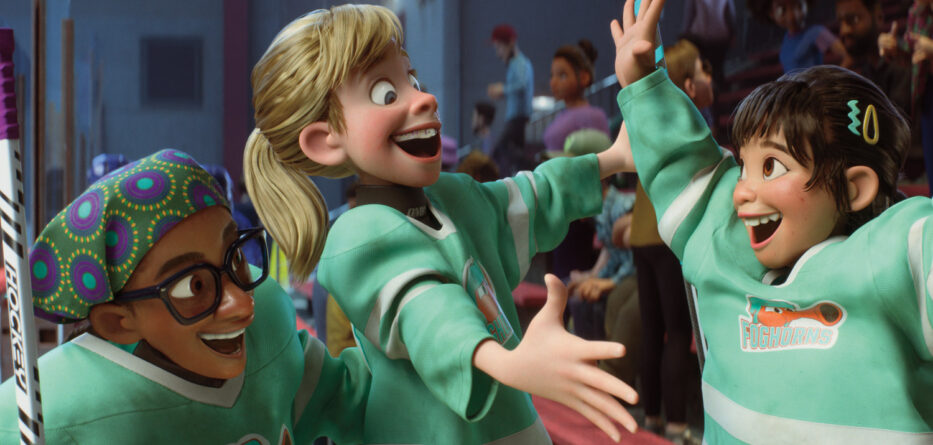Arturo Hilario
El Observador
It started out with Kelsey Mann asking Inside Out Director and current Pixar Chief Creative Officer Pete Docter a question that had been on his mind since the ending of the 2015 film.
At one point in the film the large control board the emotions use suddenly has a new addition to the controls, a dormant red siren with the word “PUBERTY” written below it. “Hey, guys, what’s PU-BER-TY?” asks Disgust (voiced by Mindy Kaling in the original). “I don’t know. It’s probably not important,” answers Joy (voiced by Amy Poehler).
As we arrive to the conclusion of the film, Riley has grown in her personality and is excited for the future, ending things on a triumphant hockey match with her team. Joy exclaims in a voiceover, “Things couldn’t be better. After all Riley’s twelve now. What could happen?”
Producer Mark Nielsen, who was the associate producer on the original, states that last line was simply a final joke for what they thought was a standalone project.
“I will say that that was not a lead in line for a sequel. We thought it’d be funny after Joy has been through all that she goes through in that movie to kind of have her forget everything that she just learned. Even though everything went upside down for her, she’s like, “Reily’s twelve now. It’s going to be great!” She’s a delusional optimist, and that’s what we love about Joy. But yeah, there was no early thinking about a sequel. It wasn’t until much later that Pete Docter asked to explore whether or not there’s another story.”
On the other hand, that last bit about “what could happen” made Mann think about what another adventure could look like for Riley as she grew into adolescence.
“I started by watching the first film with Pete, and we watched the whole thing. Then that line came at the end. I’m like, “Pete, It’s right there. Look what you did. I want to know the answer to that question.””
As Mann was working on another Pixar film at the time, he came into the viewings with Docter as an audience member with notes and that main question that persisted.
“”Well, I want that question answered. Give that to me!” And so, I was in the opportunity where I could actually make that happen.”
Docter, who won an Oscar for Best Animated Feature Film of the Year with Inside Out, asked Mann and his crew to find a reason, an answer to that question and see if it would work as a feature length film that could do justice to the memorable story of the original.
It turns out Pixar found the answer they were looking for.
Puberty & the Human Experience
Building upon that central question of “what could happen?” Inside Out 2 brings audiences back to the world of the Andersen family and most importantly, to the world inside Riley Anderson’s thoughts as she begins puberty.
This new phase in her life turns the emotions in her head into chaos as new emotion-coworkers suddenly join them, and immediately butt heads on how to best help navigate teenage Riley’s new life experiences and feelings.
The returning voice cast for the emotions includes Amy Poehler, Lewis Black, Phyllis Smith, Tony Hale and Liza Lapira (replacing Mindy Kaling), as Joy, Anger, Sadness, Fear and Disgust, respectively, while also welcoming newcomers Maya Hawke, Ayo Edebiri, Adèle Exarchopoulos, and Paul Walter Hauser as the new emotions Anxiety, Envy, Ennui, and Embarrassment.
Puberty is a universal experience as one grows out of childhood and into adolescence, and the creative team for Inside Out 2 wanted to find an honest way to tell the story with themes and situations that would resonate with a large amount of ages and experiences
For references for the film, both Mann and Nielson relied on their experiences not only as humans with emotions, but as fathers to multiple teenagers during the production.
“When I started, my daughter was 13 and my son was 14. So, I’m like this is the exact age I want her to be in the movie. And so they’re immediately right there. You’re always pulling from your lives in every movie I’ve done here. We’re always talking about what it’s like to be alive and be a person, a father, a husband, you know, whatever it may be. So, you’re always kind of putting that into the movie,” says Mann.
Nielson adds, “This really is a parental story, and even though it takes place in Riley’s mind, she is kind of the set piece and there’s something incredibly universal about this story and these emotions that we all have. And you know, even Joy who’s the protagonist of this story, has a very parental view of Riley and all the emotions do, right? They’re there to serve her. They’re there to do their very best to do whatever they need to protect their girl and to kind of steer her in the right way. And so even you know, the original film was based on Pete Docter’s observations of his daughter as she was growing up and going through change and becoming a young teen. And so having the parental lens on this film has been incredibly helpful.”
Test screenings for both the original film and the new sequel proved to be effective at communicating complex emotions and experiences with both young and adult audiences.
“It was incredible to see just how much the kids got it and understood it, almost more than the adults did. And we asked them to just explain what happened in the story they just watched, and you gotta give kids a lot of credit,” says Nielson.
Mann adds, “What’s really cool about this world of Inside Out is it gives people a language in order to talk about really complex things. And the first film really did that, especially for children. They were able to talk about their emotions and it was very exciting for us on this film in order to expand that vocabulary so that we can talk to our kids about these complicated, more complicated emotions.”
Homegrown Hockey, Pixar Style
Hockey returns to Inside Out 2 in a big way, with Riley now fully embracing her sport of choice from the first film. This time around though, hockey becomes more difficult as she begins to experience internal conflict and difficulties that stem from trying to impress her future high school team at tryout camp without losing her best friends who have played alongside her for years.
The scenes we previewed at Pixar Studios looked incredible, from the movement to the editing – the hockey footage is a great time to watch play out, and a perfect catalyst for the various new emotions that Riley will face.
For the story aspect, Mann wanted to focus on the new challenges in Riley’s life by raising the stakes with hockey and her relationships within that world.
“I certainly felt this when I was a kid, and I can see it even in my own kids. You’re playing the sport that you loved as a child, and then suddenly you get into high school and you have to try out for the team. You don’t automatically make it. You might get cut. And so suddenly you’re going to a whole other level that you’re like, “Am I good enough to even play this anymore?””
“We wanted Riley to have to deal with that and to go to a whole new social group of this new high school team that she wants to be friends with. But in order to be friends with them, she has to make the team. But there’s a higher bar now. It’s not like everybody makes the team anymore. So I’m like, “I really want to lean into the hockey on this movie,” and man, did we ever.”
And since hockey is highlighted throughout the film, the creative team had to look into how to translate the sport in the most honest and realistic way into the world of Inside Out 2. For that they looked within their own employees at Pixar, as well as the Bay Area’s rich hockey culture.
As a San Jose based paper we are proud of our local professional team, the San Jose Sharks, and wondered if the proximity of Pixar to the Bay Area’s many hockey ties had any direct effect or inspiration for the filmmakers.
It turns out that in their research they did reach out to local youth hockey organizations, visited the Sharks’ public ice rinks, such as the one in Oakland and San Jose, but also received a lot of hockey education from within Pixar itself, as there were many staff members that had experience with the sport. One key staff member they relied on for support was Character Technical Director Tracey McHugh-Roberts.
“She’s a coach of youth hockey. She grew up as a hockey player [and] we named Coach Roberts in the movie after her,” Nielsen says.
This approach to bridging the emotions of the story with the sport, along with a teased surprise voice cameo from a current Professional Women’s Hockey League (PWHL) player with ties to the Sharks, should be exciting news for moviegoers who are also hockey fans.
Nielson adds, “We had a lot of people helping us keep the hockey very authentic. We wanted it to be diverse, too. There’s diversity in hockey in the Bay Area, maybe beyond what you see in other places. And because this is set in San Francisco, we love the idea of having it be more of a diverse team.”
Inside Out 2 is out in theaters on June 14, 2024.






